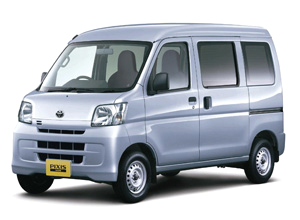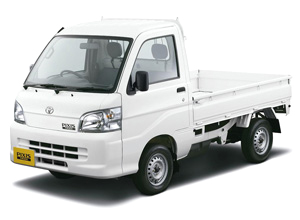Dec. 01, 2011
TMC Launches 'Pixis Truck' and 'Pixis Van' in Japan
Toyota City, Japan, December 1, 2011―Toyota Motor Corporation (TMC) today launched the "Pixis Van"1 and "Pixis Truck" in Japan. The two vehicles are the first commercial minivehicles to be launched under the Toyota brand and will be sold through more than 200 Toyota dealers nationwide.

Pixis Van Deluxe
(Front wheel drive, 5-speed manual)

Pixis Truck
Air Conditioning/Power Steering
(Four wheel drive, 5-speed manual)
Both the Pixis Van and Pixis Truck were designed for practical, commercial use, while also providing easy operation and superior environmental performance.
Square-shaped vehicle bodies provide ample cargo capacity with compact body dimensions, facilitating easy luggage loading and unloading and ease of ingress and egress. A minimum turning radius of 4.2 meters (3.7 meters for the Pixis Truck) affords excellent maneuverability.
Both vehicles are fitted with 660cc gasoline engines that offer excellent practicality and fuel efficiency. The vehicles achieve superior environmental performance and conform to Japanese 2007 exhaust emission standards under the Approval System for Low-emission Vehicles of the Ministry of Land, Infrastructure and Transport (MLIT).
The Pixis Van and Pixis Truck represent the second and third vehicles supplied by Daihatsu Motor Co., Ltd. to TMC under a minivehicle OEM agreement reached in September 2010.
Assembly Plant: Oita (Nakatsu) Plant, Daihatsu Motor Kyushu Co., Ltd.
Square-shaped vehicle bodies provide ample cargo capacity with compact body dimensions, facilitating easy luggage loading and unloading and ease of ingress and egress. A minimum turning radius of 4.2 meters (3.7 meters for the Pixis Truck) affords excellent maneuverability.
Both vehicles are fitted with 660cc gasoline engines that offer excellent practicality and fuel efficiency. The vehicles achieve superior environmental performance and conform to Japanese 2007 exhaust emission standards under the Approval System for Low-emission Vehicles of the Ministry of Land, Infrastructure and Transport (MLIT).
The Pixis Van and Pixis Truck represent the second and third vehicles supplied by Daihatsu Motor Co., Ltd. to TMC under a minivehicle OEM agreement reached in September 2010.
Assembly Plant: Oita (Nakatsu) Plant, Daihatsu Motor Kyushu Co., Ltd.
Pixis Van ― Manufacturer's Suggested Retail Prices
| Grade | Roof | Seating | Engine | Transmission | Driveline | Price* | |||
| High | 2 and 4 | KF (660cc) |
5MT | Rear-wheel drive | 910,000 yen | ||||
| Special | Four-wheel drive | 1,040,000 yen | |||||||
| 4AT | Rear-wheel drive | 970,000 yen | |||||||
| Four-wheel drive | 1,100,000 yen | ||||||||
| Clean | 4AT | Rear-wheel drive | 990,000 yen | ||||||
| Four-wheel drive | 1,120,000 yen | ||||||||
| Deluxe | 5MT | Rear-wheel drive | 1,000,000 yen | ||||||
| Four-wheel drive | 1,130,000 yen | ||||||||
| 4AT | Rear-wheel drive | 1,060,000 yen | |||||||
| Four-wheel drive | 1,190,000 yen | ||||||||
| Cruise | 5MT | Rear-wheel drive | 1,090,000 yen | ||||||
| Four-wheel drive | 1,220,000 yen | ||||||||
| 4AT | Rear-wheel drive | 1,150,000 yen | |||||||
| Four-wheel drive | 1,280,000 yen | ||||||||
| Cruise Turbo | KF (with intercooler-equipped turbo) (660cc) |
5MT | Rear-wheel drive | 1,185,000 yen | |||||
| Four-wheel drive | 1,315,000 yen | ||||||||
| 4AT | Rear-wheel drive | 1,265,000 yen | |||||||
| Four-wheel drive | 1,395,000 yen | ||||||||
*Includes consumption tax, does not include recycling fees and differs in Hokkaido; subtract 10,000 yen for standard roof option |
|||||||||
Pixis Truck ― Manufacturer's Suggested Retail Prices
| Grade | Deck | Seating | Engine | Transmission | Driveline | Price* | |||
| Length | Height | Material | |||||||
| 1,940 mm |
285 mm |
Antirust steel |
2 | KF (660cc) |
5MT | Rear-wheel drive | 590,000 yen | ||
| Special | Four-wheel drive | 760,000 yen | |||||||
| 4AT | Rear-wheel drive | 700,000 yen | |||||||
| Four-wheel drive | 850,000 yen | ||||||||
| Air Conditioning/ Power Steering |
5MT | Rear-wheel drive | 725,000 yen | ||||||
| Four-wheel drive | 875,000 yen | ||||||||
| 4AT | Rear-wheel drive | 815,000 yen | |||||||
| Four-wheel drive | 965,000 yen | ||||||||
| Agriculture | 5MT | Four-wheel drive | 905,000 yen | ||||||
| Extra | 5MT | Rear-wheel drive | 920,000 yen | ||||||
| Four-wheel drive | 1,045,000 yen | ||||||||
| 4AT | Rear-wheel drive | 985,000 yen | |||||||
| Four-wheel drive | 1,110,000 yen | ||||||||
*Includes consumption tax, does not include recycling fees and differs in Hokkaido |
|||||||||
Vehicle Outline
Highly Practical Cabin with Ample Cargo and Deck Space
Both vehicles are designed to offer comfortable daily use, with the convenient layout of the instrument panel and control switches around the driver's seat ensuring easy operation.
Pixis Van
The gear stick has been shifted to the instrument panel to create uncluttered legroom and enhance the comfort of the interior. A large glove compartment, in-door storage trays and other such features create ample storage space for enhanced utility.
In the Deluxe or Special grade with high roof and 2-passenger configuration, the Pixis Van boasts the largest cargo space for its class2 (1,860 × 1,315 × 1,235 mm). The vehicle's square structure makes use of every cubic centimeter, allowing the large-capacity cargo area to be filled from corner to corner.
Two side sliding doors (770 mm × 1,190 mm) and a rear-hatch door (1,335 mm × 1,145 mm) provide expansive openings which, in addition to a cargo area only 635 mm off the ground enhance ease of loading and unloading.
Pixis Truck
The wheel housing for the Pixis Truck has been shifted to under the seats for unimpeded front passenger legroom. In addition to a large central instrument panel pocket and glove compartment, numerous storage areas provide abundant and convenient storage space.
The cargo deck, with a class-leading2 length of 1,945 mm from guard frame to rear, features a thin, flat guard frame that does not protrude over the deck and makes it efficient and simple to neatly load boxed cargo.
Gasoline Engine Excels in Practicality, Fuel Efficiency and Environmental Performance
For both the Pixis Truck and Pixis Van, a 660 cc KF engine with Dynamic Variable Valve Timing (DVVT3) in combination with a 3-speed or 4-speed automatic transmission (AT) or a 5-speed manual transmission (MT) enables both highly responsive city driving and smooth operation at high speeds. The Pixis Van Cruise Turbo features an intercooler-equipped turbo. All models conform to the 2007 exhaust emissions standards.
Pixis Van
Rear-wheel drive, MT models4 realize class-leading fuel efficiency of 17.0 km/L in the 10-15 test cycle outlined by MLIT (equivalent to 137 g/km of CO2 emissions). Rear-wheel-drive-MT and four-wheel-drive model fuel efficiency exceeds Japan's 2010 standards5 by 5% and rear-wheel-drive AT models (except Cruise Turbo rear-wheel-drive AT) exceed the standards by 10%.
Pixis Truck
Rear-wheel drive, MT models offer class-leading fuel efficiency of 17.8 km/L in the 10-15 test cycle (equivalent to 130 g/km of CO2 emissions). Rear-wheel-drive-MT and four-wheel-drive-AT models exceed Japan's 2010 standards by 5% and rear-wheel-drive AT models exceed the standards by 10%.
Highly Practical Cabin with Ample Cargo and Deck Space
Both vehicles are designed to offer comfortable daily use, with the convenient layout of the instrument panel and control switches around the driver's seat ensuring easy operation.
Pixis Van
The gear stick has been shifted to the instrument panel to create uncluttered legroom and enhance the comfort of the interior. A large glove compartment, in-door storage trays and other such features create ample storage space for enhanced utility.
In the Deluxe or Special grade with high roof and 2-passenger configuration, the Pixis Van boasts the largest cargo space for its class2 (1,860 × 1,315 × 1,235 mm). The vehicle's square structure makes use of every cubic centimeter, allowing the large-capacity cargo area to be filled from corner to corner.
Two side sliding doors (770 mm × 1,190 mm) and a rear-hatch door (1,335 mm × 1,145 mm) provide expansive openings which, in addition to a cargo area only 635 mm off the ground enhance ease of loading and unloading.
Pixis Truck
The wheel housing for the Pixis Truck has been shifted to under the seats for unimpeded front passenger legroom. In addition to a large central instrument panel pocket and glove compartment, numerous storage areas provide abundant and convenient storage space.
The cargo deck, with a class-leading2 length of 1,945 mm from guard frame to rear, features a thin, flat guard frame that does not protrude over the deck and makes it efficient and simple to neatly load boxed cargo.
Gasoline Engine Excels in Practicality, Fuel Efficiency and Environmental Performance
For both the Pixis Truck and Pixis Van, a 660 cc KF engine with Dynamic Variable Valve Timing (DVVT3) in combination with a 3-speed or 4-speed automatic transmission (AT) or a 5-speed manual transmission (MT) enables both highly responsive city driving and smooth operation at high speeds. The Pixis Van Cruise Turbo features an intercooler-equipped turbo. All models conform to the 2007 exhaust emissions standards.
Pixis Van
Rear-wheel drive, MT models4 realize class-leading fuel efficiency of 17.0 km/L in the 10-15 test cycle outlined by MLIT (equivalent to 137 g/km of CO2 emissions). Rear-wheel-drive-MT and four-wheel-drive model fuel efficiency exceeds Japan's 2010 standards5 by 5% and rear-wheel-drive AT models (except Cruise Turbo rear-wheel-drive AT) exceed the standards by 10%.
Pixis Truck
Rear-wheel drive, MT models offer class-leading fuel efficiency of 17.8 km/L in the 10-15 test cycle (equivalent to 130 g/km of CO2 emissions). Rear-wheel-drive-MT and four-wheel-drive-AT models exceed Japan's 2010 standards by 5% and rear-wheel-drive AT models exceed the standards by 10%.
1Inspired by the word pixie
2Comparison with other cab-over minivehicles
3Registered trademark of Daihatsu Motor Co., Ltd.
4Excluding Cruise Turbo grade
5Specified under the Japanese Law Concerning the Rational Use of Energy
2Comparison with other cab-over minivehicles
3Registered trademark of Daihatsu Motor Co., Ltd.
4Excluding Cruise Turbo grade
5Specified under the Japanese Law Concerning the Rational Use of Energy






